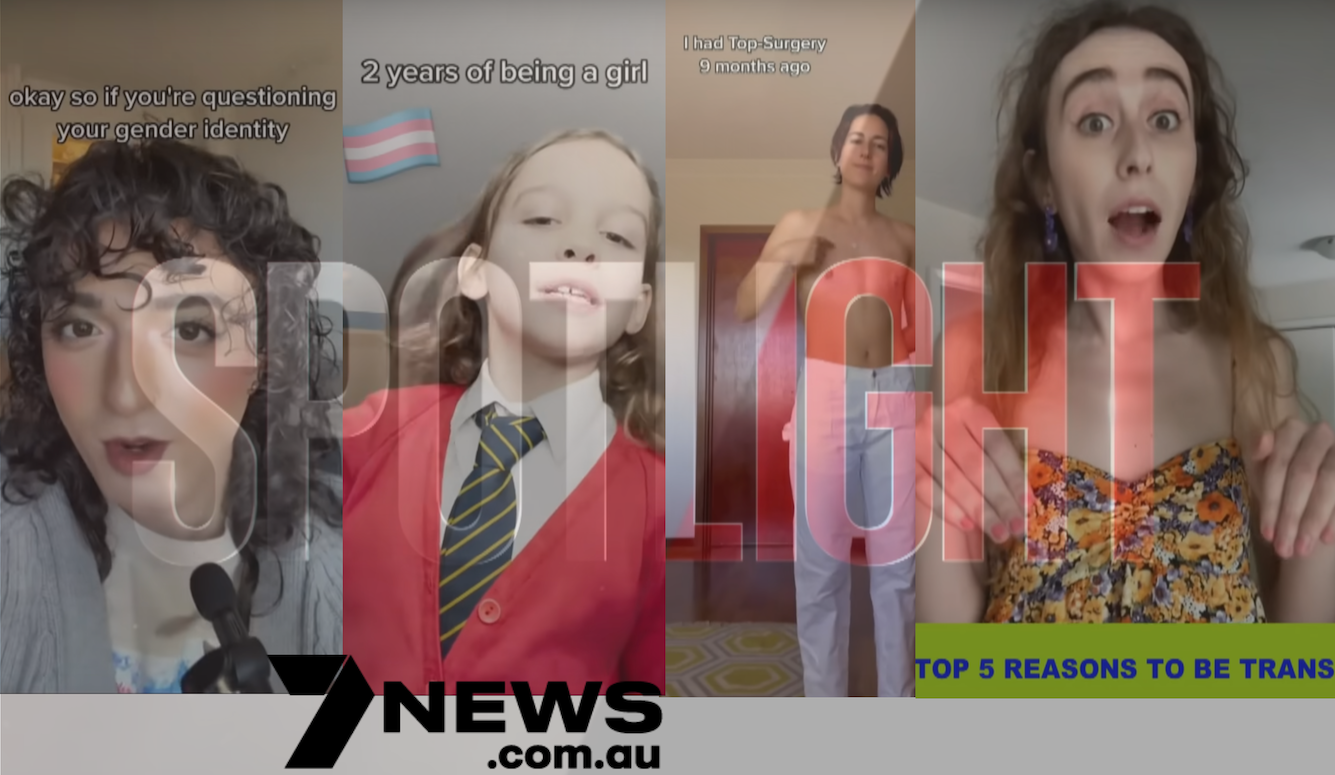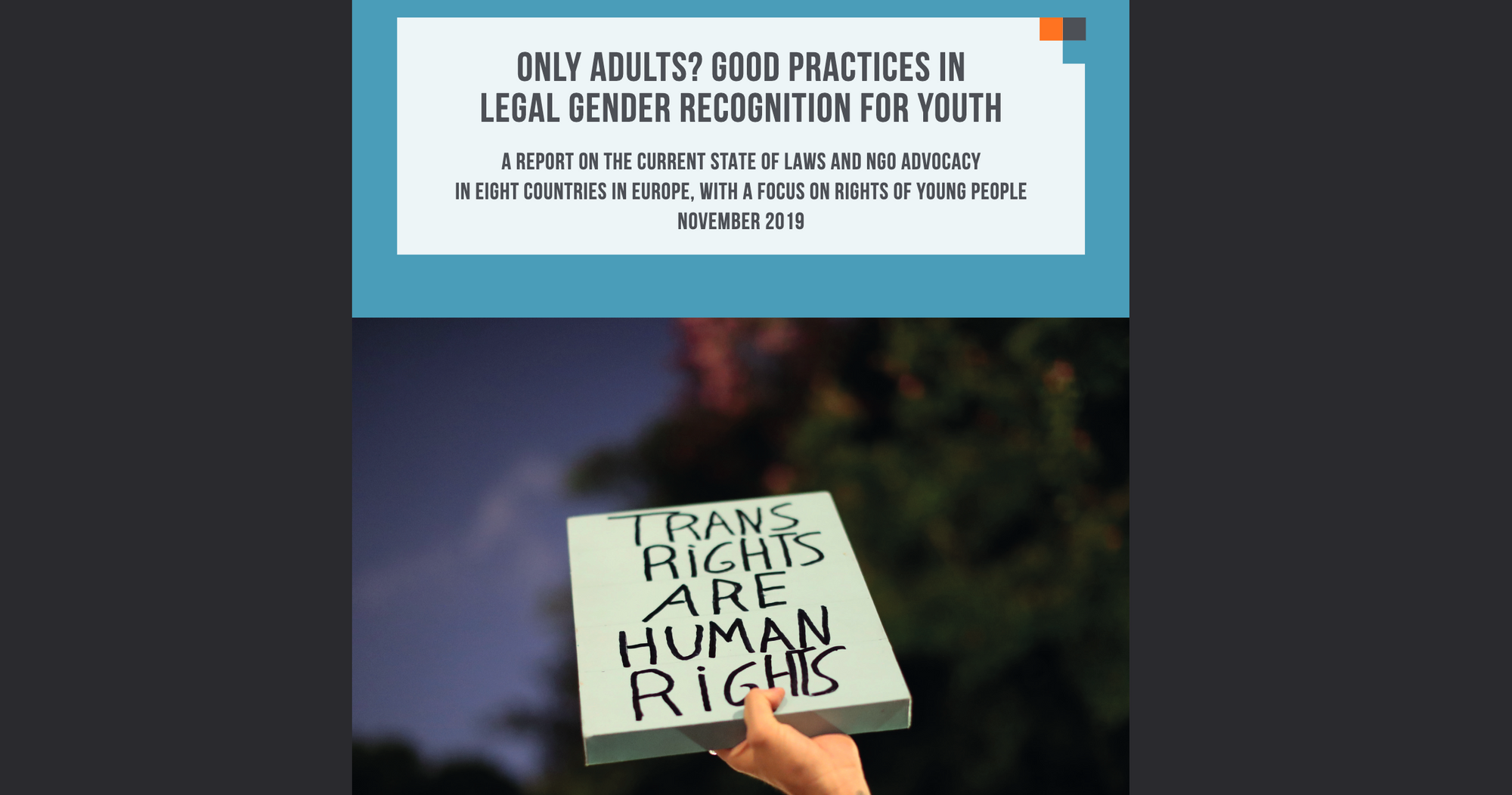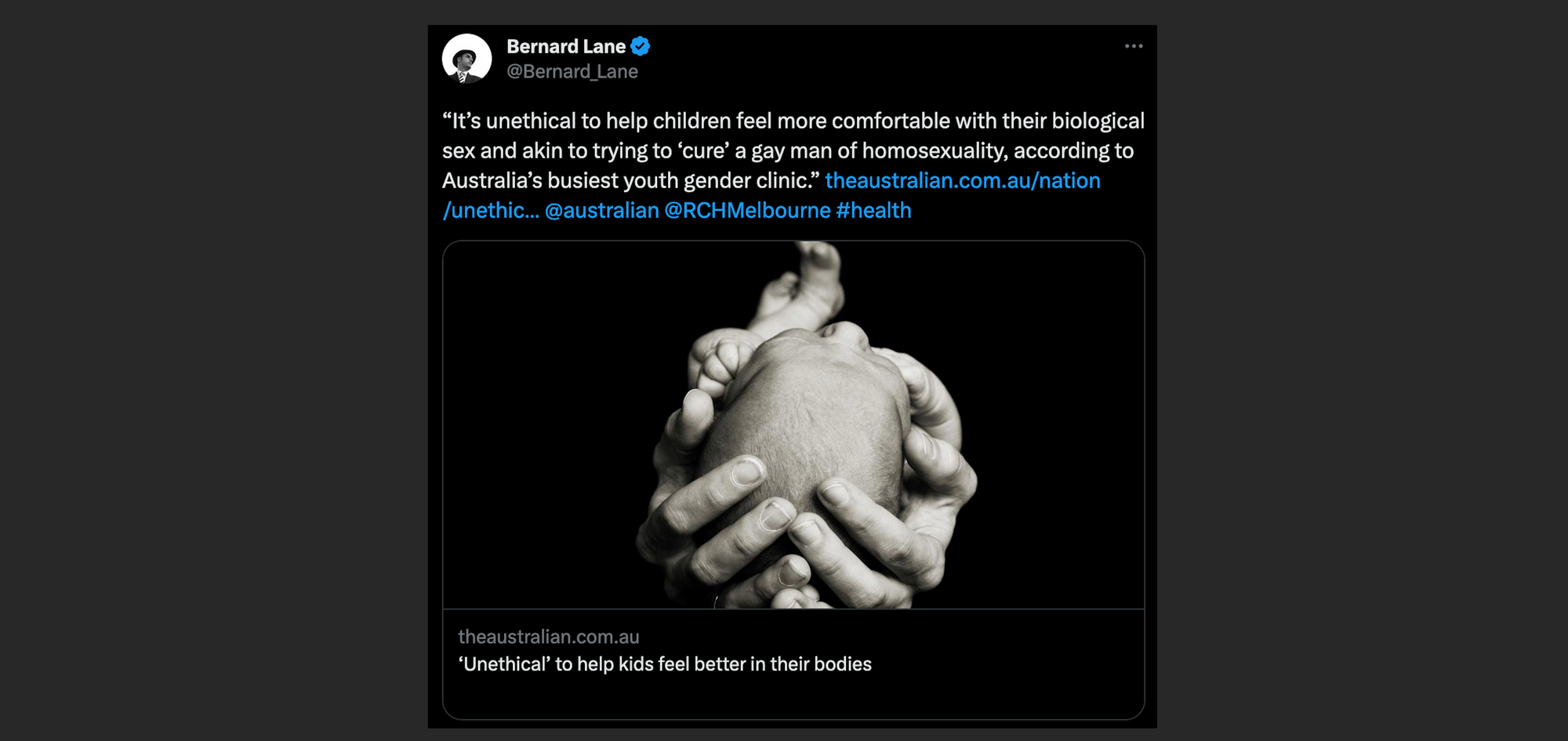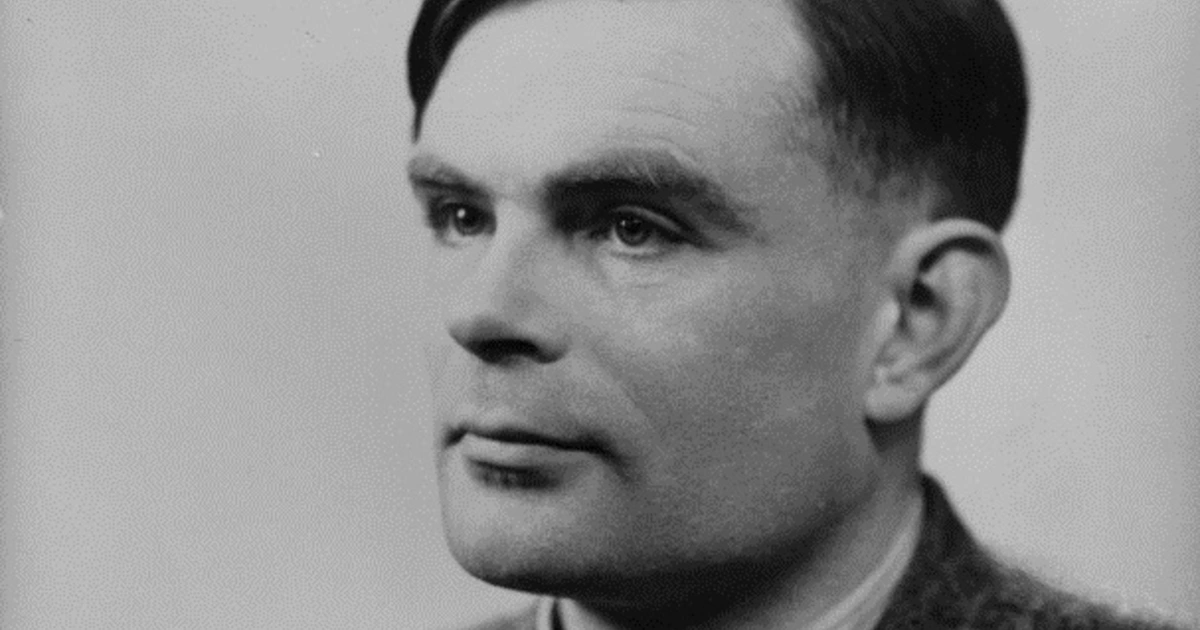Gender Dysphoria
How Australia’s Press Council Has Been Used to Stifle the Gender Debate
In their reporting on the medicalisation of dysphoric children, Australian journalists are now expected to comply with media guidelines drafted at the behest of trans activists.

By now, more than 800,000 Australian television viewers have watched De-Transitioning, a recently aired documentary from the Seven News Spotlight program. The feature, billed as Spotlight’s “most controversial story this year,” represented a breakthrough moment for Australian media coverage of gender clinics. Instead of showing viewers the usual parade of joyful-seeming families preaching the wonders of trans “affirmation,” Seven News spoke with thoughtful dissenting doctors, and regretful de-transitioners whose anguished rejection of womanhood had led them to the surgical removal of healthy body parts.
As one might expect, trans activists and their media allies attacked Seven News for airing the program. Yet it shouldn’t be contentious for journalists to challenge medicalised gender change and the dogmatic claims made on its behalf.
De-Transitioning isn’t the first English-language television documentary about de-transitioners. But this kind of journalism remains rare, as the mere mention of de-transition serves to challenge the conceit that everyone, even small children, has an unerring (and therefore unfalsifiable) sense of their “gender identity.” (Certainly, nothing like De-Transitioning has ever appeared on Australia’s public broadcaster, the ABC.)
Most major medical societies have bought into this mindset as well—which helps explain why not a single children’s hospital gender clinic took up Seven News’ invitation to put its case to a television audience. Gender clinicians have come to expect uncritical support from the fourth estate. And so they generally refuse to engage with any journalist seen as sceptical, or who may also be talking to ideological “enemies.”
A similar climate of media self-censorship exists in other parts of the English-speaking world. But the situation in Australia is unusual, because the taboo against even-handed journalism on the gender file has gained institutional support from the country’s Press Council—which, by its own description, “sets standards and responds to complaints about material in Australian newspapers and magazines.”
As discussed below, I have been the subject of some of those complaints, and so I have been forced to reflect on how such complaints might be assessed.
On August 26, the Press Council ruled against a columnist who’d stated, correctly enough, that the decision to close Britain’s Tavistock gender clinic came “after an inquiry concluded [that] allowing often confused and immature children to transition to another gender put them ‘at considerable risk.’” The Council held this to be factually inaccurate, on the spurious grounds that the risk identified by the investigating paediatrician, Hilary Cass, was simply “the model of care” involving a single overburdened national clinic, and “not the act of gender transition itself.”
In rendering this decision, the Council was repeating a misleading activist talking point—that the Cass Review was actually aimed at expanding the availability of puberty-blocker drugs and cross-sex hormones for minors. In fact, as anyone following the Cass Review process would have expected, Britain’s National Health Service responded to the review by announcing plans to restrict blockers to a formal research setting (which is unsurprising given the impoverished evidence base).

The (real) Tavistock narrative undermines the case for a streamlined “gender-affirming” approach to the transition of minors. And it is a disgrace that Australia’s Press Council, which purports to champion “freedom of speech and responsible journalism,” has censured a journalist for saying so, while substituting its own misinformation.
The Press Council is a member-funded body that has no legal authority to regulate Australian news outlets or impose penalties on journalists. Nevertheless, its pronouncements are seen to carry some measure of moral authority. That authority is being squandered through its apparent determination to stigmatize dissenting views on the transgender medicalisation of childhood.
The idea that the media is in the grip of this or that lobby group is a common culture-war claim, of course. But in this case, the agenda at play is quite explicit. In 2019, the authors of a report titled Only Adults? Good Practices in Legal Gender Recognition for Youth—funded and produced by a progressive media foundation, a collection of blue-chip trans activist groups, and several multinational law firms—endorsed a strategy based on
the limitation of press coverage and exposure. In certain countries, like the UK, information on legal gender recognition reforms has been misinterpreted in the mainstream media, and opposition has arisen as a result … Against this background, many believe that public campaigning has been detrimental to progress, as much of the general public is not well informed about trans issues, and therefore misinterpretation can arise. In Ireland, activists have directly lobbied individual politicians and tried to keep press coverage to a minimum in order to avoid this issue.
Other tips contained in the Dentons Report (as its known, in reference to one of its law-firm sponsors) include getting the jump on devising trans-related policies before governments have time to craft their own proposals; yoking trans rights to more popular causes, such as gay rights; and lobbying individual politicians on a targeted basis. As noted in the block quote above, open persuasion in the town square is presented as risky, on the basis that the “general public” is too ignorant to appreciate the arcane dogmas of gender ideology.

In some cases, activist groups have tried to shut down debate by trumpeting flat-out medical misinformation. In 2018, Rainbow Rights Watch, a small Australian group of trans activists, issued a report entitled, Translating Transphobia: Portrayals of Transgender Australians in the Press 2016-2017. Among the targets of complaint catalogued therein was an opinion article noting (correctly) that cross-sex hormones carry “risks ranging from sterility to cancer.”
Rainbow Rights Watch sought to justify its complaint with the misleading claim that “all of the hormonal medications prescribed for the management of gender dysphoria in Australia are approved” by government regulators. In fact, puberty blockers and cross-sex hormones are approved for other medical conditions—but not for gender dysphoria. When it comes to trans-identified youth, the prescription of such drugs has been conducted on an off-label basis.
In December 2019, The Australian—the country’s well-respected national daily newspaper—reported that this “little-known transgender lobby group”—i.e., Rainbow Rights Watch—had been “responsible for almost half of all [Press Council] complaints lodged against the nation’s major media outlets.” This amounted to 165 out of 387 complaints that had been active for more than seventeen weeks.

In his foreword to the Council’s 2018-19 annual report, chair Neville Stevens argued that new editorial guidelines were required to serve evolving “community expectations” in regard to “reporting on persons with diverse sexual orientation, gender identity and sex characteristics.” These guidelines, he added, should be informed by, among other parties, “persons with lived experience.” No prizes for guessing what the (redundant) phrase “lived experience” means in this context.
At the time, I was already writing regularly on this issue for The Australian. A few months before the Press Council published its guidelines, I had approached the gender clinic at the Royal Children’s Hospital Melbourne (RCH)—the country’s leader in the national dissemination of “gender-affirming” care—seeking to interview a clinician for an article I was researching. This request was refused, as was my request for treatment data. Instead, I was referred to the clinic’s “internationally recognised” treatment advice.
That 2018 document, badged as “Australian Standards of Care,” turned out to be scientifically contested. As I would later report in The Australian, the clinic’s standards document arguably lack a cautious approach to medical treatment and overplays the weak evidence base.

The Press Council’s guidelines reflect the same jargony propaganda style employed by the activists whose “lived experience” the Council had sought out. Biological sex, for instance, is referred to as sex “assigned at birth.” To such extent as journalists agree to impose this usage on readers, they would only be promoting the confused belief that sex is something arbitrary and changeable. (For the activists who demand the use of this kind of terminology, that is, of course, the point.)
One authority cited by the Press Council (and given pride of place under the attached list of “International and national media guidelines”) is the U.S. group GLAAD, which once lobbied for gay rights but has now increasingly pivoted to trans-rights advocacy. In 2021, GLAAD tried to shut down a landmark CBS 60 Minutes story on regretful de-transitioners before it had gone to air. Its list of “terms to avoid” for journalists includes “biologically male” and “biologically female,” on the basis that such phrases “inaccurately imply that a trans person is not who they say they are.”

Another authority repeatedly cited by the Press Council is ACON, a Sydney-based group originally created in response to the AIDS epidemic, but which, like GLAAD, has now largely shifted focus to trans affirmation. It wants everyone to avoid terms such as “gender reassignment” and “sex change,” in favour of “gender-affirming healthcare”—a euphemism for drug and surgical interventions. ACON’s TransHub site also tells us that “front hole” is the term “preferred by some trans men and non-binary people to describe their genitals.” How long before the Press Council urges its members to employ such terminology in the name of evolving “community expectations”?
Elsewhere in the Press Council guidelines, the authors urge journalists writing about gender issues to “consult” with “representational bodies.” Of course, it’s always a good idea for journalists to interview experts, especially in regard to complex medical topics. But in the gender-clinic context, this kind of guideline effectively channels journalists to activist outlets, since widely quoted groups such as The Australian Professional Association for Trans Health (AusPATH) have taken on a political mission that goes well beyond dispensing neutral scientific advice.
One factor that helps explain why bodies such as the Press Council have submitted to activist demands is the conceit that such demands are analogous to the campaigns for racial equality, sexual equality, and gay rights in years past. On this view, those who respond quickly and enthusiastically to trans-activist demands will be remembered as being on the right side of history; while those who offer even mild dissent are accused of stepping into the shoes of yesterday’s bigots, sexists, and homophobes. But this line of argument ignores the fact that none of those antecedent movements pushed invasive medical treatments on children, nor spread the myth that one can be “born in the wrong body,” nor demanded that women share intimate spaces with biologically intact males who use female pronouns.
In fact, one of the reasons why progressive gay-rights groups such as Britain’s LGB Alliance are now choosing to distance themselves from trans advocacy is that they recognize an identifiably regressive strain in the trans-rights movement.

Consider, by way of historical example, the case of Alan Turing, the English mathematician who gained fame for his role in cracking the Enigma Code used by the Nazi military command during World War II. A homosexual (this being the term then used), Turing was convicted of “gross indecency” in 1952. He was told to choose between prison and chemical castration with estrogen. He opted for the pills, whereupon he grew breasts, became impotent, and lapsed into depression. It’s hard to see his treatment as anything other than “conversion therapy.” Yet today’s gender non-conforming male youth—many of whom would likely emerge as healthy gay men if not medicalised—get the message that they are actually girls. At ages as young as ten-to-twelve years old, their puberty is interrupted with hormone-suppression drugs—also used to chemically castrate sex offenders—followed by estrogen, the risks of which include breast cancer, stroke, and sterilisation. And yet this harm—this identity conversion—is celebrated as “gender-affirming hormone therapy.”
During my three decades spent working as an Australian journalist, I’d never previously had to defend a complaint before the Press Council. My reporting on gender issues exposed me to other “firsts” as well. For the first time in my career, I was told that asking questions about the harms associated with a particular kind of medical procedure was off limits. For the first time in my career, a medical institution flat-out refused to subject itself to accountability regarding its practices. For the first time in my career, I was besieged by activists—some moonlighting as journalists—who insisted that subjecting the truth of their slogans to scrutiny might drive fragile youth to suicide.
I received smears and death threats, as well, of the type journalists more typically face when writing about cults, criminal syndicates, or terrorist groups. One might think all of this would be of concern to a group such as the Australian Press Council, whose self-professed goal is “promoting high standards of media practice, community access to information of public interest, and freedom of expression through the media.” Instead, the Council’s guidelines encoded many of the same demands issued by those who wanted me to stop doing my job.
As noted above, the Press Council’s pronouncements aren’t legally binding. Nevertheless, journalists may suffer professional consequences if their work is held to be flawed by this august-sounding body. Members of the public, and even other journalists, are likely to take its tribunal judgments at face value, and conclude that an unfavourable judgment amounts to a meaningful form of censure. In a December 2019 column I wrote for The Australian, I predicted that the Council’s guidelines on gender would “lead to journalists being smeared as hateful transphobes.” I was proven correct.
While the Press Council claims that journalists were consulted during the process of drafting its guidelines, none of the senior editors at The Australian whom I spoke with could remember being asked their opinion. When I asked the Press Council for an interview with someone who’d been involved in the development of the guidelines, I initially got a positive response—but then nobody was made available. Instead, I was sent a media statement to the effect that press freedom must be balanced against journalism’s “harmful effect[s]”; no evidence of this harm was provided.
I requested a list of those who’d been consulted by the Council. This, too, was denied—in the name of “privacy.” Here’s another first I can report: In every other context, journalists demand more information, more data, more transparency. When it comes to this issue, however, there appears to be an official policy of secrecy and stonewalling.
Two days after the Press Council’s public unveiling of its new guidelines (formally designated as “advisory guidelines for reporting on persons with diverse sexual orientation, gender identity, and sex characteristics”), Australia’s Star Observer (“setting Australia’s LGBTI agenda since 1979”) quoted ACON—and its Victorian state-level counterpart, Thorne Harbour Health—as welcoming the new diktat, and noting that they’d both taken part in the consultation. Needless to say, both organisations promote the speedy “affirmation” of trans-identified youth, including access to life-altering medical interventions.
The Star Observer article began as follows:
[Following a] number of slanted articles published by The Australian vilifying Australia’s trans and gender diverse community, and other anti-LGBTQI reports across Australia’s media landscape, the Australian Press Council has released advisory guidelines for reporting on persons with diverse sexual orientation, gender identity, and sex characteristics.
Just in case any reader might miss the barbed reference to my own investigative reports at The Australian, the accompanying photo consisted of a cropped montage of my work.
It’s worth recalling the stated mission of the press council, which includes “keeping under review, and where appropriate, challenging developments which may adversely affect the dissemination of information of public interest and may consequently threaten the public’s right to know.” The misinformation and pressure campaign waged by trans-rights activists represents precisely such a development.
It’s understandable that the Press Council, caught in a blizzard of orchestrated complaints, might see appeasement as a way out. But such a response only serves to empower vexatious complainants. The Press Council’s duty is to challenge threats to the public’s right to know—not try to strike compromises with those making the threats.
Did the Press Council also consult with the RCH Melbourne gender clinic or AusPATH? At the time, both were led by paediatrician Michelle Telfer, who was also listed as the first author on those aforementioned 2018 Australian Standards of Care. Dr. Telfer had enjoyed a high media profile in Australia, despite having made dubious claims about gender medicine. In 2015, she was quoted as saying that puberty blockers “don’t stop growth generally, or your brain from maturing emotionally and cognitively, they just stop the sexual characteristics from developing.” In fact, the effects of blockers on the adolescent brain are unknown. In 2022, belatedly, the RCH clinic informed patients and parents that it was launching a new research project on the subject, acknowledging that “we do not know whether using puberty blockers affects development of the brain.”

It goes without saying that Dr. Telfer and her three overlapping professional roles in this field would be relevant to any journalistic investigation into how the gender-affirming treatment model became dominant in Australia. This is why I cited her pronouncements many times in my coverage for The Australian, while always giving her gender clinic an opportunity to comment.
The Australian also offered her a spot on the newspaper’s high-profile opinion page, so she could relate her side of the story. This offer was rejected. As far as I know, the newspaper received no letters to the editor alleging any inaccuracy in regard to my reporting about gender clinics. Nevertheless, in 2020, Dr. Telfer filed an omnibus Press Council complaint against me, impugning any article that mentioned her—more than forty in total.
The case gained some attention in Australia, as activists (correctly) saw it as a test of their ability to weaponize the Press Council and its new guidelines against journalists who failed to toe the ideological line. In a September 3, 2021 decision, the Council upheld Dr. Telfer’s complaint, if only in part. (Just in case the language in the ruling might be upsetting, a trigger-warning message appeared at the bottom, directing distraught readers to various LGBTQ+ groups.)
There were three alleged infractions identified in the ruling. The first pertained to my (correct) report that The Royal Australian and New Zealand College of Psychiatrists (RANZCP) had begun implicitly shifting to a more cautious approach on youth gender transition. This was indicated by a stealth edit of its LGBTIQ+ mental-health position statement, from which it removed its former endorsement of the RCH Australian Standards of Care, pending a review of the evidence.
The Press Council agreed with Dr. Telfer’s hair-splitting complaint that RANZCP had not explicitly disavowed her standards of care. And yet, the words of endorsement had been cut from the policy document, and they were never to return.
The Council seemed oblivious to the tortuous politics surrounding the issue: RANZCP moved quietly precisely so as to avoid being denounced by trans activists. Going after me for pointing out that experts in other countries were beginning to reject Dr. Telfer’s “gender-affirming” position amounted to shooting the messenger.
Of course, like any other citizen, she was entitled to make a complaint. But the Press Council had a duty to judge her complaint impartially, especially given that the subject matter involved the safety of vulnerable children and risky medical technologies.

The remaining two issues identified by the Press Council related to questions of judgment; and in both cases, the Council upheld the gender-affirming viewpoint.
One involved the question of expertise: On the experimental nature of youth gender treatments, I’d quoted Carl Heneghan, Professor of Evidence-Based Medicine at Oxford University, who’d undertaken a review of the evidence for the use of puberty blockers and cross-sex hormones in 2019. The relevant expertise here is evidence-based medicine—which is what health authorities in Sweden, Finland, and the UK have relied upon in adopting their own more cautious treatment policies following systematic reviews of the evidence base since 2019. But the Council deferred to Dr. Telfer’s argument that, in a controversy about a particular treatment, the true experts are the clinicians who use that treatment. Which is a neat, if indirect, way of discouraging journalists from interviewing sceptical medical experts, since doctors who use a particular treatment also tend to be the ones who want to tell the world how safe and effective they are.
The final issue concerned the balance between emotional distress and the public interest. The Council held that the distress caused Dr. Telfer could not be justified, and that my coverage was too personal in tone. This analysis failed to acknowledge her three overlapping roles: Covering this issue properly simply could not be done without noting how much policy-setting power was held by a single doctor with a high media profile as a trans-rights advocate.
Moreover, the Council failed to identify any personal attacks in my articles. That’s because there were none. Quite the opposite: my coverage acknowledged that Dr. Telfer “genuinely believes [that] ‘affirmation’ and sometimes medical transition is vital for the mental health of her young patients.”
By contrast, Dr. Telfer herself has felt at liberty to impugn my own motives. At the 2019 AusPATH conference, she reportedly said that The Australian’s coverage was “driven by fear and hate [and] aimed to create and escalate fear, to [promote] a particular religious and political agenda.”
I don’t doubt that Dr. Telfer was distressed to see her views being scrutinized in an influential newspaper such as The Australian. But I believe the potential harm to children from mistaken medical interventions must be given more weight than the hurt feelings of a clinician.
Moreover, it has become clear to me that the whole gender-affirming movement comes with a lot of built-in “distress” by way of ideological design. As many Quillette writers have noted, supporters of on-demand youth transition therapies tend to divide the world sharply into caring “allies” and supposedly transphobic ideological enemies.

It must be distressing to truly believe that one is surrounded by so much hate and bigotry. It’s not a worldview that children should be encouraged to adopt. Yet, we hear the constant claim that any expression of caution or dissent in gender medicine will drive trans-identified children to suicide. This reckless trope is used to end debate before it begins. Even sporadic acts of misgendering and deadnaming are spoken of as serious, possibly even fatal barbs. At the same time, advocates of this gender-affirming ideology seem oblivious to the irreversible harm done to young people, such as those profiled by the Seven News De-Transitioning program, who bitterly regret medicalised gender change and its side effects.
We are witnessing an emerging medical scandal. And one reason for this is that over the last decade, journalists have failed to do their jobs. The result has been that everyone—from parents to physicians to policymakers—has been misled by superficial and one-sided media coverage that failed to interrogate grandiose claims based on slim evidence.
We are starting to see a journalistic correction now, which means that decision-makers in medical societies, hospitals, and politics will have a broader, more accurate information base to guide them. And it’s encouraging to see younger journalists stepping up to do this necessary reporting. But being at an early stage of their careers, they are more at risk of reputational damage from activist attacks. They shouldn’t have to face the extra hazard presented by the Press Council and its ideological-torqued guidelines.








